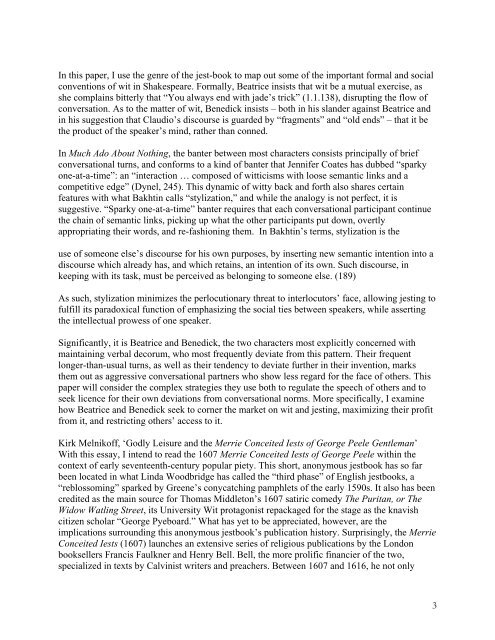1 Jests in Early Modern Culture Seminar Leader - Shakespeare ...
1 Jests in Early Modern Culture Seminar Leader - Shakespeare ...
1 Jests in Early Modern Culture Seminar Leader - Shakespeare ...
Create successful ePaper yourself
Turn your PDF publications into a flip-book with our unique Google optimized e-Paper software.
In this paper, I use the genre of the jest-book to map out some of the important formal and social<br />
conventions of wit <strong>in</strong> <strong>Shakespeare</strong>. Formally, Beatrice <strong>in</strong>sists that wit be a mutual exercise, as<br />
she compla<strong>in</strong>s bitterly that “You always end with jade’s trick” (1.1.138), disrupt<strong>in</strong>g the flow of<br />
conversation. As to the matter of wit, Benedick <strong>in</strong>sists – both <strong>in</strong> his slander aga<strong>in</strong>st Beatrice and<br />
<strong>in</strong> his suggestion that Claudio’s discourse is guarded by “fragments” and “old ends” – that it be<br />
the product of the speaker’s m<strong>in</strong>d, rather than conned.<br />
In Much Ado About Noth<strong>in</strong>g, the banter between most characters consists pr<strong>in</strong>cipally of brief<br />
conversational turns, and conforms to a k<strong>in</strong>d of banter that Jennifer Coates has dubbed “sparky<br />
one-at-a-time”: an “<strong>in</strong>teraction … composed of witticisms with loose semantic l<strong>in</strong>ks and a<br />
competitive edge” (Dynel, 245). This dynamic of witty back and forth also shares certa<strong>in</strong><br />
features with what Bakht<strong>in</strong> calls “stylization,” and while the analogy is not perfect, it is<br />
suggestive. “Sparky one-at-a-time” banter requires that each conversational participant cont<strong>in</strong>ue<br />
the cha<strong>in</strong> of semantic l<strong>in</strong>ks, pick<strong>in</strong>g up what the other participants put down, overtly<br />
appropriat<strong>in</strong>g their words, and re-fashion<strong>in</strong>g them. In Bakht<strong>in</strong>’s terms, stylization is the<br />
use of someone else’s discourse for his own purposes, by <strong>in</strong>sert<strong>in</strong>g new semantic <strong>in</strong>tention <strong>in</strong>to a<br />
discourse which already has, and which reta<strong>in</strong>s, an <strong>in</strong>tention of its own. Such discourse, <strong>in</strong><br />
keep<strong>in</strong>g with its task, must be perceived as belong<strong>in</strong>g to someone else. (189)<br />
As such, stylization m<strong>in</strong>imizes the perlocutionary threat to <strong>in</strong>terlocutors’ face, allow<strong>in</strong>g jest<strong>in</strong>g to<br />
fulfill its paradoxical function of emphasiz<strong>in</strong>g the social ties between speakers, while assert<strong>in</strong>g<br />
the <strong>in</strong>tellectual prowess of one speaker.<br />
Significantly, it is Beatrice and Benedick, the two characters most explicitly concerned with<br />
ma<strong>in</strong>ta<strong>in</strong><strong>in</strong>g verbal decorum, who most frequently deviate from this pattern. Their frequent<br />
longer-than-usual turns, as well as their tendency to deviate further <strong>in</strong> their <strong>in</strong>vention, marks<br />
them out as aggressive conversational partners who show less regard for the face of others. This<br />
paper will consider the complex strategies they use both to regulate the speech of others and to<br />
seek licence for their own deviations from conversational norms. More specifically, I exam<strong>in</strong>e<br />
how Beatrice and Benedick seek to corner the market on wit and jest<strong>in</strong>g, maximiz<strong>in</strong>g their profit<br />
from it, and restrict<strong>in</strong>g others’ access to it.<br />
Kirk Melnikoff, ‘Godly Leisure and the Merrie Conceited Iests of George Peele Gentleman’<br />
With this essay, I <strong>in</strong>tend to read the 1607 Merrie Conceited Iests of George Peele with<strong>in</strong> the<br />
context of early seventeenth-century popular piety. This short, anonymous jestbook has so far<br />
been located <strong>in</strong> what L<strong>in</strong>da Woodbridge has called the “third phase” of English jestbooks, a<br />
“reblossom<strong>in</strong>g” sparked by Greene’s conycatch<strong>in</strong>g pamphlets of the early 1590s. It also has been<br />
credited as the ma<strong>in</strong> source for Thomas Middleton’s 1607 satiric comedy The Puritan, or The<br />
Widow Watl<strong>in</strong>g Street, its University Wit protagonist repackaged for the stage as the knavish<br />
citizen scholar “George Pyeboard.” What has yet to be appreciated, however, are the<br />
implications surround<strong>in</strong>g this anonymous jestbook’s publication history. Surpris<strong>in</strong>gly, the Merrie<br />
Conceited Iests (1607) launches an extensive series of religious publications by the London<br />
booksellers Francis Faulkner and Henry Bell. Bell, the more prolific f<strong>in</strong>ancier of the two,<br />
specialized <strong>in</strong> texts by Calv<strong>in</strong>ist writers and preachers. Between 1607 and 1616, he not only<br />
3


